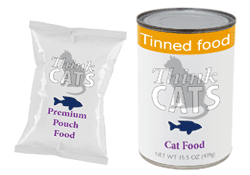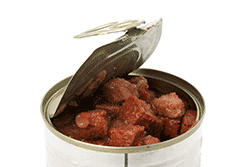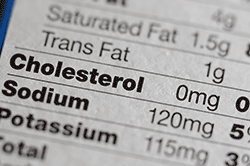Commercial foods
Most cat owners will feed a commercial, branded, food to their cat, and these 'complete' foods give your cat everything it needs to stay healthy

Wet or dry?
Off the shelf commercial foods should always make up at least 90% of your cats diet, with treats making up the rest. Prepared foods are often referred to as wet, semi-wet, or dry depending on their water content. Tinned and pouch foods are normally 'wet' and come in gravy or jelly, treats in stick or pate form are 'semi-wet' and biscuits are 'dry'. Your cat will get most of its hydration from its food rather than water on its own so it is important to feed wet or semi-wet foods and have dry foods as an addition. A commercial food is safe, covers all your pet's nutritional requirements, and will provide information on feeding guides.
Which brand?
Each brand of cat food will tell you it is the most nutritional, tastiest, or contains essentials that no other cat food does. Whilst this is mostly marketing hype, there can be big differences between the 'big brands' and the 'bargain basement' foods. Always feed either a known brand food, or own-brand food from a big chain - Big chains like well-known pet stores, or supermarkets, generally have their foods made by the big cat food companies anyway. If its in the same size pouch, with the same seal, and the same nutritional values, and the same flavours, its a good bet it is exactly the same food and just had a different label put on at the factory. However, be wary of any cheap foods which you do not recognise, or have not seen on sale elsewhere. Whilst these may be fine, they may also be 'bulked out' with non-nutritional foods, and may not contain all the essentials your cat needs to stay healthy.
Special formulas
Go into any big pet store and you will find rows of shelves dedicated to all types of food for different cat breeds, weights and ages. Some of the differences are dubious, others may be worth considering, none are worth worrying too much about. If you have kittens, feed food appropriate for their age up to one year old, then they can go on adult food and if you have an old cat, feed a senior food. Apart from that, any other choice is down to you and your cat to decide.

Tinned wet foods are good value, but need to be stored properly
Tinned foods
Tinned foods tend to be the cheapest and have the longest shelf-life, so its always useful to have a few tins in case you run out of food. There is enough food in a tin to last three feeds for an average cat. You can store the open tin in the fridge to keep it fresh, although some cats won't eat food when its cold so it will need to be warmed up before serving (not hot, warm or room temperature) Be careful not to leave opened tins where your cat can get at them or the cat is at risk of getting its head stuck, possibly causing suffocation, or cutting itself on the sharp edges.
Pouch foods
Although tinned foods are cheaper, pouch foods are more popular due to their convenience. Pouch foods are essentially single servings, which means no messy half opened tins lying around or producing odours in the fridge. Simply open a pouch, slip the fresh contents in a bowl, and bin the empty pack.

Commercial 'complete' foods provide a well balanced diet
Sticks & pate foods
These are 'semi-wet' foods which have a moisture content somewhere between the jelly or gravy rich wet foods, and dry biscuit foods. Sticks can be fed as treats to your cat, or as an additional midday feed between two main meals. Pate foods tend to be marketed as containing more enticing flavours and of a higher quality than mainstream pouches or tins. In terms of nutritional value, tins and pouches are just as good, if not better than sticks or pates, but these foods can make good treats or occasional alternatives to your cats normal food.
Dry foods
Dry cat biscuits, also known as 'kibble' are also well balanced 'complete' foods, but contain less meat and more cereal, bulking out substances, or vegetable extracts. Whilst wet foods are used as 'meals', often eaten all in one go, biscuits should be considered as a 'top-up' food, available to your cat at all times to dip into whenever it feels like it. Since biscuits are a dry food, they can be left out for a day or more without going off. Providing a dry biscuit all the time can actually help to keep a cat's weight down - If your cat knows food is always available, it does not have to worry about going hungry, and is more likely to regulate its own eating.



